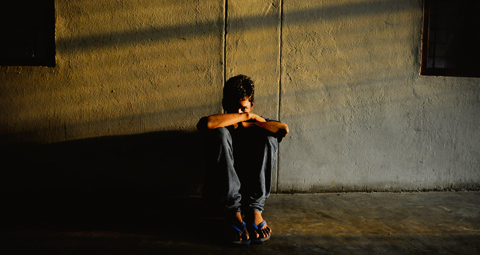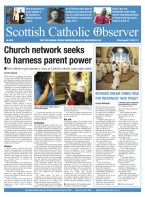August 4 | ![]() 0 COMMENTS
0 COMMENTS ![]() print
print

Robbed of their childhood: the Indian teenagers trafficked for sex
SCIAF’S JANICE BURNS explains how the Catholic charity is helping save young children from slavery - BY JANICE BURNS
THE Scottish Catholic International Aid Fund (SCIAF) has launched an urgent appeal highlighting the plight of thousands of vulnerable children in India who are being trafficked for cheap labour, the sex trade, organ harvesting and forced marriage.
Human trafficking is one of the fastest growing illegal trades in the world, generating a profit of over £1 billion a year. In India alone, around 20,000 people were trafficked last year—10,000 of them were children.
Nearly 80 per cent of those who are trafficked are girls, mostly destined for cheap labour and the sex industry, and aged between 10 and 14 years. They are often condemned to a life of working long hours in dangerous conditions, violently beaten and sexually abused.
According to figures released by the European Parliament last year, more than 20 million people have been trafficked worldwide, with grinding poverty, a lack of education and opportunities, war and political instability being the key drivers to making people more vulnerable to trafficking and modern-day slavery.
SCIAF has just begun a new project in India, working with Caritas India and others, to raise awareness of the problems in poor communities so they’re less likely to be duped by traffickers.
This includes supporting particularly poor families to increase their income so parents aren’t so desperate that they feel the best option for their child is to be sent away from home.
SCIAF is also working with border authorities to set up interception booths at key points on the border with Nepal, publicising a free government helpline which children can call, and working with police to help rescue children when possible.
SCIAF’s communications manager Val Morgan, who travelled to India recently to see the project, said: “Child trafficking is destroying lives. Right now in India, thousands of children are being bought and sold, forced to work long hours in dangerous conditions with little or no pay, no rights and often violently beaten and sexually abused.
“Every child has the right to love, safety, an education and a future of hope. We can all do something to help these vulnerable children.
“SCIAF started to work with Caritas India and others to help stop this appalling trade and protect vulnerable children and their families.
“We’re going to be raising awareness of the problem and how to avoid falling prey to traffickers in villages along the border between India and Nepal, where an estimated 43 per cent of cases pass through.
“We’ll be training and helping poor families to grow food and earn an income so they’re less likely to fall prey to traffickers’ lies, and work with the police and others to identify trafficked children.
“We’re also going to be helping to set up interception booths along the border to help identify trafficked children wherever we can.”
Many poor communities targeted by child traffickers are unaware of the fact that they or their loved ones have been sold, sometimes even years after it has happened. In India, traffickers are often known to families who are deceived into believing their children will be given an education and brighter future.
During his trip to India, Mr Morgan met staff from different organisations working with SCIAF on the child trafficking project, including Caritas India, Childline 1908, Night and Day, as well as vulnerable children and families.
“Human traffickers often deceive desperately poor families into believing that if their child goes with them they’ll receive an education, be given well-paid work and have a better future,” Mr Morgan said. “Sadly, the traffickers and their agents are often known to the child or their family, so they trust them and don’t realise the danger they’re in until it’s too late.
“An important part of the project involves setting up interception booths at key points along the border with Nepal, publicising the government-funded Childline free national telephone number that children and parents can call if they need help, and working with police, railway and bus station workers, rickshaw drivers and community leaders to identify and rescue children whenever possible.
“The human cost of this callous trade cannot be understated.”
Caritas India project manager Leeza, responsible for this vital work, said child trafficking affects the emotional wellbeing of the young survivors.
“Their removal from their parents and community has a big impact on them,” she said. “Depending on the case, they can be left feeling psychologically disturbed, depressed, vulnerable, frightened, lonely and cheated. It can affect their mental and physical health.
“They are not allowed to have their own childhoods. Their childhoods are lost. They are not able to get an education. Their health suffers. There is no future for these children. In India, we say that if the development of a child is affected, the development of the nation is affected.
“Our work in schools, villages and with the police will be important. We hope the project will bring down the number of cases of human trafficking and build a network for the future to increase support for these vulnerable children.
“I want to thank the Scottish people for showing interest in the vulnerable women and children of our country. Through your support we will be providing them with a bright future.”
Rama Thapa, a case worker in India for Childline, which is working closely with Caritas India to combat child trafficking, told how they rescued one young girl from the clutches of traffickers.
“Last year there was a girl called Monica—she was 14 years old,” she said. “She was from Delhi and was in Basti, the next district to Gorokhpur. Delhi Childline called us to say a girl had been sold and was in Basti. So we went for one week to Basti. We just had one phone number which the girl had called from and said ‘rescue me.’
“We informed the police here and they called the Basti police. They monitored the phone and identified the area code. We went to the village with the police and asked people if they knew of a girl called Monica.
The villagers told us such a girl had got married and they told us where she lived.
“We went to the house but said we were from the government and doing a survey. We asked who lived in the house and for their names. That’s how we found her and then she was rescued.
“The girl was from a slum area in Delhi. Her father was a poor street vendor. There was a women agent called Kiren who moved into the area three or four months before.
“She made friendships with girls, including Monica, bought them sweets and took them to different places.
“She told Monica she had a brother-in-law who would marry her. Kiren told her not to mention anything to her parents until after she was married. She brought Monica by train to Basti. They sat in different carriages and were told to say she was going to study.
“Monica was brought to a village and to a man’s house. Kiren sold her to the man for Rs35,000 (£415).
“They were then married, but it wasn’t a proper marriage. Monica was the third girl to be married to this man. The two previous girls had been sold on to other men for sex.
“The man was around 25 years old and sexually abused her. When Monica was rescued Kiren ran away and the police have not followed up the search for her. The police in these cases just want to wash their hands of them. But if Kiren was caught other children would be saved.
“The man has not been prosecuted. We are getting so many cases but we aren’t able to deal with them all. If we get support from you, our team will get stronger and we will be able to protect more children.”
– To support SCIAF’s work with poor and vulnerable communities in India and around the world, visit: www.sciaf.org.uk/donate or call 0141 354 5555.










